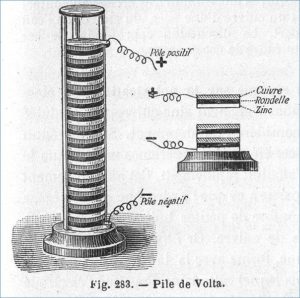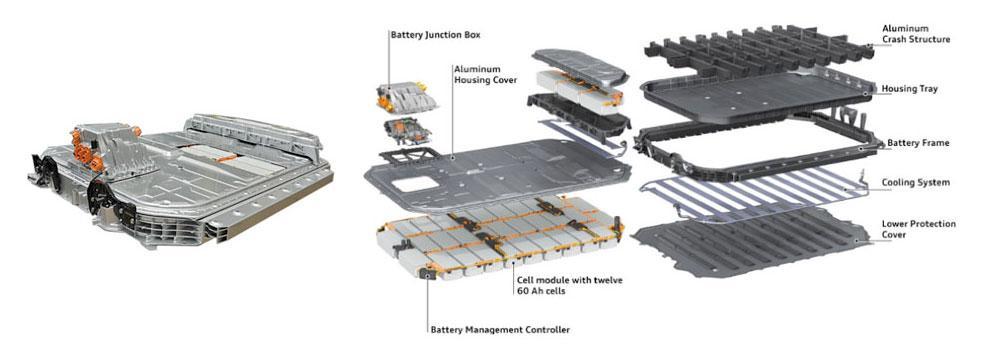The battery has revolutionized the way we live, producing a reliable and portable power source for a wide range of products. The concept of batteries has a rich history that spans centuries, possibly even millennia. As far back as the 1st century AD, civilizations may have been experimenting with battery concepts, with artifacts discovered around Baghdad that resemble battery-like devices. However, the true purpose of these devices remains controversial.
Alessandro Volta and the Birth of the Battery

At the turn of the 19th century electricity was becoming an increasing topic of study. People were finding various ways to produce or store electric current but there was as of yet no way to produce a continuous flow of electricity.
In 1799 the Italian physicist Alessandro Volta solved this problem and first reported his findings in a letter to the Royal Society in 1800. Called a Voltaic pile, Volta stacked zinc, copper, and brine-soaked paper in layer after later, sometimes referred to as a voltaic cell. Adding a wire to both ends produced an electric current, with additional layers creating a stronger current. These additional layers stacked on top of each other created the voltaic pile. Volta realized that somehow the piles of metal disks were producing the current, an effect called an electromotive force.
In 1810 Humphry Davy showed that it was the chemical reaction between the two metals (electrode) and the liquid solution (electrolyte). Various difference metals and solutions can be used all to create an electromotive force.
The voltaic pile marked a significant milestone in the history of electricity. It was the first true electric battery, setting the stage for the development of modern batteries.
Unleashing the Power of Chemical Energy
A battery is then a chemical means of generating electricity. It works through a “redox” reaction, which is the process of reduction (one substance gaining electrons) and the process of oxidation (one substance losing electrons) occurring simultaneously. To perform the redox reaction most batteries consist of two electrodes – an anode (negative electrode) and a cathode (positive electrode) – separated by an electrolyte, which is a conductive material. The electrodes are typically made of two different materials, and the electrolyte allows ions to flow between them while preventing contact. When the battery is connected to an external circuit, the redox chemical reaction occurs within the battery, producing the flow of electrons from the anode to the cathode, creating an electrical current that can be used to power devices.
Volta’s battery is called a wet battery. While it did produce a controlled, continuous flow of electric current it was not very practical. There were significant limitations with its capacity, size, and portability. The battery was a large and cumbersome device and had a low energy density compared to modern batteries. What it was however, was a groundbreaking invention that paved the way for further development of battery technology. It was not until a dry battery was invented, which replaced the liquid electrolyte with a paste, that batteries portable and practical.
The Rise of Practical Batteries
The battery has undergone significant changes in the past two centuries since the invention of the voltaic cell. Here are a few notable improvements:
- Daniell Cell: In 1836, the British scientist John Frederic Deniell invented a new cell using copper sulfate and zinc sulfate, separated by a porous pot, to create a longer-lasting source of power.
- Lead-Acid Batteries: In 1859 the French physicist Gaston Plante invented the first rechargeable battery.
- Leclanche Cell: In 1866, the French engineer Georges Leclanche patented a new kind of battery – a predecessor to the modern dry cell battery. It used a zinc anode and a manganese dioxide cathode wrapped in a porous material, dipped in a jar of ammonium chloride.
- Nickel-Cadmium Batteries: In 1899 the Swedish inventory Waldemar Jungner invented the first alkaline battery.
- Lithium-ion Batteries: Lithium is the metal with the greatest electrochemical potential. These batteries did not come to market until the 1970s and offer the highest densities and can hold its charge for the longest period of any battery.

(Credit: aec.org)
Peering into the future batteries will increasingly play a role in society. Emerging technologies such as artificial intelligence (AI), renewable energy storage, advanced portable devices, and electric vehicles (EVs) will need powerful batteries to conveniently function. As a result many of these industries are investing heavily in battery technology. Improved battery technology will enable the widespread adoption of many of these technologies, removing their limitations and making the more appealing to consumers.
Continue reading more about the exciting history of science!
Thank you for this history lesson. Batteries have made a great contribution in my house as it seems I’m always buying them.
I had no clue about the history behind the battery. It’s definitely something we take for advantage in our everyday lives.
This is very interesting! I think the early Egyptians were using batteries too.
I would have never guessed the battery was invented back in 1799. The wet batteries must have been incredibly heavy. I can’t imagine life without dry batteries these days!
Love learning new things so i enjoyed reading this post. it’s amazing something we still use very much today
I had no idea the battery was invented so long ago! This was a very interesting read.
This was such an interesting and informational read! I honestly didn’t know any history related to how batteries were created.
I should let my girls read this. They love all things science, and I bet they’d find the history lesson fascinating – so thanks for sharing!
I never ever thought about the history of a battery until now. You have made me even more curious to do more research
A battery the best device that provided us to power electrical devices…:) great source
Hmmmm. So interesting if this storage of energy will be replaced by something better. So excited for the future.
Very interesting article. I showed it to my son too.
Such a cool, short, concise history lesson! Definitely want to see more.
Wow… the number of things that we just take for granted every day that had to be created thanks to someone’s genius and creativity. This makes me stop for a minute to be grateful to those people for what we have.
The history of inventions always gets me so excited that I feel like I should also invent something in my current space. Anyway, I hadn’t thought about invention of the battery, only electricity. But it was nice to learn this.
So much new information I didn’t know before. Thank you for sharing it
Laura
https://pinkfrenzymissl.blogspot.com/
We use batteries every day in so many different things, but never really pause to think about it! Interesting facts.
– Nandita
I had no idea so much went into creating a non-stop flow of electricity to power a battery. Thank for sharing!
Loved your post,Very informative,it is good to know about invention
So interesting! I didn’t know about how the battery was created before this.
You always find the best new information to write about! I’m always smarter after your posts!
SO interesting! I love learning how things work, especially items I use on a daily basis!
I was really amazed about how batteries works, thanks for sharing this wonderful article about how the batteries were invented..
Thank you for sharing, I love a great history lesson!
Very interesting! I think the new generation should read more stuff like this instead to wast time on social. Thank you for sharing
I love learning how things work! I miss school says for that reason so this was a refreshing read!